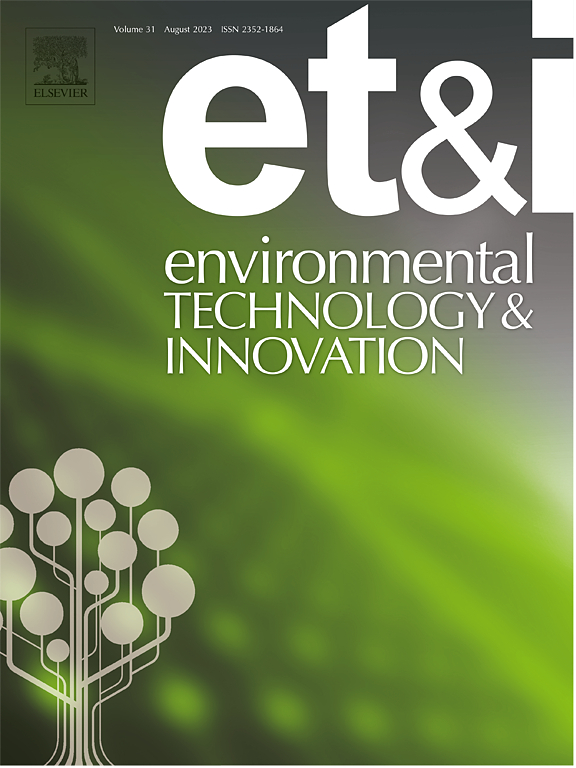Effects of biochar combined with different nitrogen fertilization rates on turf quality and carbon footprint in a turf system
IF 6.7
2区 环境科学与生态学
Q1 BIOTECHNOLOGY & APPLIED MICROBIOLOGY
引用次数: 0
Abstract
Biochar has been widely recognized for its potential to mitigate greenhouse gas emissions and enhance soil fertility through increased soil organic carbon (SOC) storage; however, systematic evaluations of carbon balance and ecological benefits in turf systems remain scarce. This study included eight treatments combining four N (nitrogen) rates (N0: 0, N1: 150, N2: 225, N3: 300) kg N ha−1 with two biochar practices (SB0: 0, SB:40) t ha−1. The results showed that biochar application treatments (N0SB, N1SB, N2SB, and N3SB) reduced cumulative fluxes of soil N2O and CH4 (global warming potential, GWP) by 17.37 %, 26.62 %, 32.73 %, and 30.97 %, net global warming potential (NGWP) 43.71 %, 369.64 %, 1046.17 %, and 545.83 %, and CF by 32.01 %, 192.81 %, 356.66 %, and 253.34 %, while increasing SOC sequestration by 129.20 %, 138.61 %, 133.89 %, and 133.61 %, total biomass by 3.99 %, 14.22 %, 15.51 %, and 14.78 %, and turf normalized difference vegetation index (NDVI) by −0.18 %, 2.81 %, 2.81 %, and 1.89 % compared to non-biochar treatments. Although biochar slightly increased ecosystem respiration, the effect was not significant (p > 0.05). Notably, compared to N3SB, N2SB significantly reduced N2O by 12.85 %, CH4 by 11.47 %, CF (carbon footprint) by 16.01 %, and NGWP by 9.82 %, while ecosystem respiration, SOC storage, turfgrass total biomass, and NDVI exhibited no significant differences between the two treatments. Overall, the co-application of biochar with 225 kg N ha−1 is a win−win strategy for reducing CF, enhancing carbon sequestration, and maintaining turf quality.
生物炭配施不同氮肥量对草坪质量和碳足迹的影响
生物炭因其减少温室气体排放和通过增加土壤有机碳(SOC)储存提高土壤肥力的潜力而被广泛认可;然而,对草皮系统碳平衡和生态效益的系统评价仍然缺乏。本研究包括8个处理,分别采用4种N(氮)处理(N0: 0, N1: 150, N2: 225, N3: 300) kg N ha - 1和2种生物炭处理(SB0: 0, SB:40) t ha - 1。结果表明,生物炭应用治疗(N0SB, N1SB, N2SB N3SB)累积通量降低土壤一氧化二氮和甲烷(全球变暖的潜力,GWP) 17.37 % 26.62 %, % 32.73和30.97 %,净全球变暖潜力(NGWP) 43.71 % 369.64 %, % 1046.17和545.83 %, % CF, 32.01, 192.81 %, % 356.66和253.34 %,同时增加了SOC封存了129.20 %,138.61 %, % 133.89和133.61 %,总生物量 % 3.99,14.22 %, % 15.51和14.78 %,与非生物炭处理相比,草皮归一化植被指数(NDVI)分别提高了- 0.18 %、2.81 %、2.81 %和1.89 %。虽然生物炭对生态系统呼吸有轻微的促进作用,但效果不显著(p >; 0.05)。与N3SB相比,N2SB处理显著降低了N2O 12.85 %、CH4 11.47 %、CF(碳足迹)16.01 %和NGWP 9.82 %,而生态系统呼吸、SOC储量、草坪草总生物量和NDVI在两种处理之间无显著差异。总体而言,生物炭与225 kg N ha - 1共同施用是减少CF、增强碳固碳和保持草坪质量的双赢策略。
本文章由计算机程序翻译,如有差异,请以英文原文为准。
求助全文
约1分钟内获得全文
求助全文
来源期刊

Environmental Technology & Innovation
Environmental Science-General Environmental Science
CiteScore
14.00
自引率
4.20%
发文量
435
审稿时长
74 days
期刊介绍:
Environmental Technology & Innovation adopts a challenge-oriented approach to solutions by integrating natural sciences to promote a sustainable future. The journal aims to foster the creation and development of innovative products, technologies, and ideas that enhance the environment, with impacts across soil, air, water, and food in rural and urban areas.
As a platform for disseminating scientific evidence for environmental protection and sustainable development, the journal emphasizes fundamental science, methodologies, tools, techniques, and policy considerations. It emphasizes the importance of science and technology in environmental benefits, including smarter, cleaner technologies for environmental protection, more efficient resource processing methods, and the evidence supporting their effectiveness.
 求助内容:
求助内容: 应助结果提醒方式:
应助结果提醒方式:


